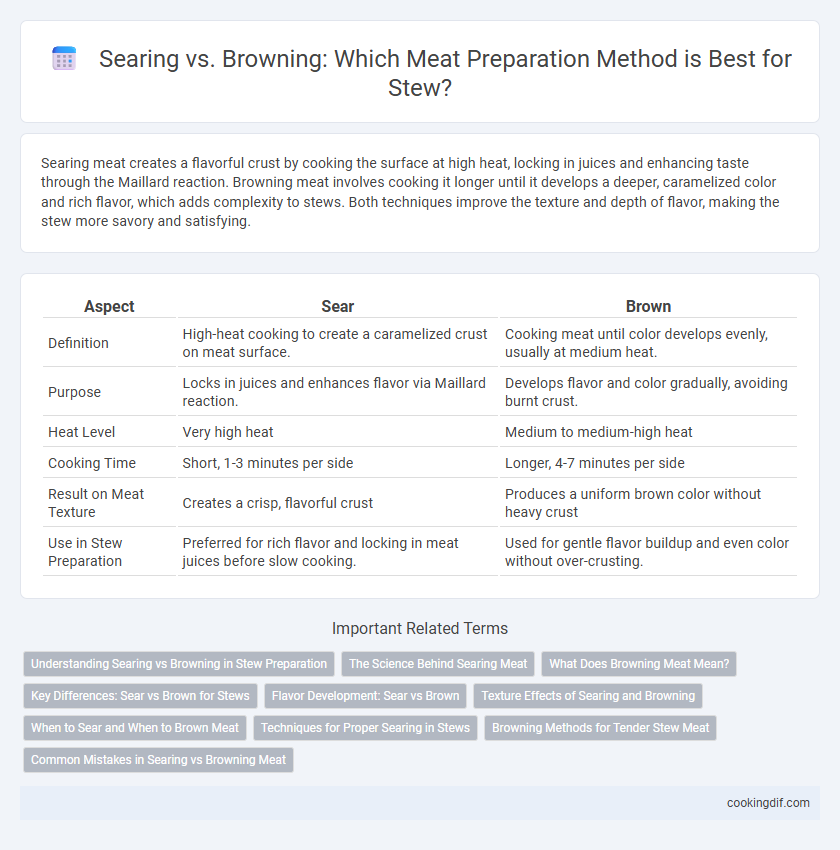Searing meat creates a flavorful crust by cooking the surface at high heat, locking in juices and enhancing taste through the Maillard reaction. Browning meat involves cooking it longer until it develops a deeper, caramelized color and rich flavor, which adds complexity to stews. Both techniques improve the texture and depth of flavor, making the stew more savory and satisfying.
Table of Comparison
| Aspect | Sear | Brown |
|---|---|---|
| Definition | High-heat cooking to create a caramelized crust on meat surface. | Cooking meat until color develops evenly, usually at medium heat. |
| Purpose | Locks in juices and enhances flavor via Maillard reaction. | Develops flavor and color gradually, avoiding burnt crust. |
| Heat Level | Very high heat | Medium to medium-high heat |
| Cooking Time | Short, 1-3 minutes per side | Longer, 4-7 minutes per side |
| Result on Meat Texture | Creates a crisp, flavorful crust | Produces a uniform brown color without heavy crust |
| Use in Stew Preparation | Preferred for rich flavor and locking in meat juices before slow cooking. | Used for gentle flavor buildup and even color without over-crusting. |
Understanding Searing vs Browning in Stew Preparation
Searing meat involves cooking it at high heat to create a flavorful crust through the Maillard reaction, which locks in juices and enhances taste. Browning refers to the gradual color change during cooking that develops deeper flavors and caramelization on the meat's surface. In stew preparation, searing is critical for creating a rich, savory base, while browning contributes to overall depth and complexity of the dish's flavor profile.
The Science Behind Searing Meat
Searing meat in stew preparation triggers the Maillard reaction, a chemical process that develops complex flavors and rich aromas by browning amino acids and sugars on the meat's surface. This reaction enhances the depth of taste and creates a savory crust that locks in juices, improving overall texture and moisture retention during slow cooking. Browned meat provides a more flavorful base for the stew by intensifying umami compounds that are essential for a well-rounded, hearty dish.
What Does Browning Meat Mean?
Browning meat refers to the process of cooking the surface of the meat at a high temperature until it develops a rich, caramelized crust, enhancing flavor through the Maillard reaction. This technique is essential in stew preparation as it locks in juices and adds depth to the overall taste profile. Searing differs from simple browning by using higher heat intensity for a more pronounced crust, which intensifies the meat's savory characteristics.
Key Differences: Sear vs Brown for Stews
Searing meat before stewing creates a flavorful crust through the Maillard reaction, enhancing taste and texture by locking in juices, while browning involves gently cooking the meat to develop color and mild caramelization without creating a crust. Searing is performed at higher temperatures and shorter times to create a distinct crust, whereas browning is done at moderate heat to evenly color the meat and deepen the stew's overall flavor. The choice between sear and brown impacts both the mouthfeel and richness of the final stew, influencing how robust and complex the flavor profile becomes.
Flavor Development: Sear vs Brown
Searing meat creates a rich, caramelized crust through the Maillard reaction, intensifying the flavor by locking in juices and adding a deep, savory note. Browning meat gradually develops complex flavors by slowly rendering fat and allowing gentle caramelization, which enhances the overall depth without a charred surface. Both techniques contribute unique flavor profiles essential for a well-balanced stew, with searing providing intense initial flavor and browning building layered richness throughout the cooking process.
Texture Effects of Searing and Browning
Searing meat during stew preparation creates a caramelized crust that enhances texture by adding a slight crispness and rich flavor complexity. Browning, achieved through slower cooking, breaks down collagen in tougher cuts, resulting in a tender, melt-in-the-mouth consistency essential for hearty stews. The contrast between seared crustiness and browned tenderness balances the stew's overall mouthfeel and depth.
When to Sear and When to Brown Meat
Searing meat is ideal for larger cuts in stews to create a caramelized crust that enhances flavor through the Maillard reaction, especially when cooking low and slow. Browning ground or smaller pieces is preferred to develop a deep, uniform color and prevent steaming, which helps build a rich base for sauces. Choosing between searing and browning depends on meat size and desired flavor intensity, with searing taking longer but yielding a more intense taste.
Techniques for Proper Searing in Stews
Proper searing techniques for stew involve heating the pan until it reaches a high temperature to achieve the Maillard reaction, which forms a flavorful brown crust on the meat. Using a heavy-bottomed skillet and ensuring the meat is dry before placing it in the pan prevents steaming and encourages even browning. Sear the meat in batches without overcrowding to maintain consistent heat and develop a rich, deep flavor essential for hearty stews.
Browning Methods for Tender Stew Meat
Browning methods such as searing or browning enhance flavor through the Maillard reaction, creating a rich crust on tender stew meat. Searing involves cooking meat at high heat quickly to lock in juices, producing a deep, caramelized exterior. Browning, often done by gently sauteing or stirring meat in batches, ensures even color and flavor development without overcooking the tender cuts.
Common Mistakes in Searing vs Browning Meat
Common mistakes in searing vs. browning meat include overheating the pan, leading to burnt exteriors and undercooked interiors, and overcrowding the pan, which causes steaming instead of proper caramelization. Using wet or improperly patted-dry meat reduces Maillard reaction effectiveness, resulting in a less flavorful crust. Additionally, prematurely stirring or flipping the meat prevents the formation of a consistent brown crust essential for deep, rich stew flavors.
Sear vs brown for meat preparation Infographic

 cookingdif.com
cookingdif.com